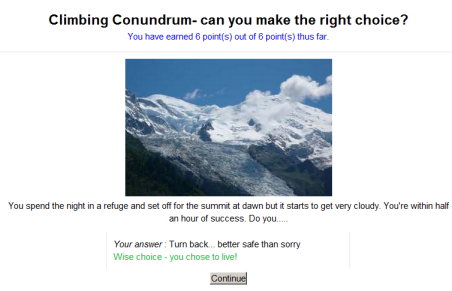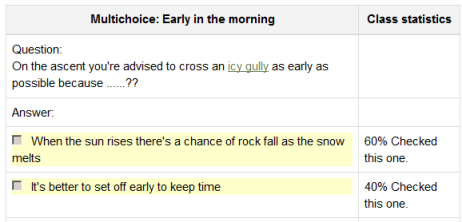Diferencia entre revisiones de «Usando Lección»
({{Pendiente de traducir}}) |
|||
| Línea 15: | Línea 15: | ||
==Lo que ve el profesor== | ==Lo que ve el profesor== | ||
* | *Un profesor que haga clic en una lección verá pestañas en la parte superior, ofreciéndoles la oportunidad de obtener una vista previa, editar, ver informes o calificar los ensayos en la lección:[[File:teacherviewoflesson.png]] | ||
[[File:teacherviewoflesson.png]] | |||
===Vista previa=== | ===Vista previa=== | ||
* | * La lección se abre en modo de vista previa para el profesor. Sin embargo, no mostrará el puntaje a menos que el maestro cambie su rol al de un estudiante. | ||
===Editar=== | ===Editar=== | ||
* | * La pestaña Editar permite a los profesores modificar la lección una vez que se ha configurado. Hay dos vistas: contraída y expandida. Consulte [[Construyendo una lección]] para obtener más detalles sobre cómo editar la lección. | ||
===Reportes=== | ===Reportes=== | ||
* | * La pestaña de informes muestra el rendimiento de los estudiantes que toman la lección. Hay una general "Información general" y una pestaña "Estadísticas detalladas". | ||
====Vista general==== | ====Vista general==== | ||
[[File:lessonreportsoverview1.png]] | [[File:lessonreportsoverview1.png]] | ||
Revisión del 17:44 28 nov 2018
Esta página describe cómo los estudiantes y profesores interactúan con las lecciones de Moodle una vez que han sido creadas. Para los detalles acerca de cómo configurar y después organizar una lección, vea Configuraciones de lección y Construyendo una lección
Nota: Pendiente de Traducir. ¡Anímese a traducir esta página!. ( y otras páginas pendientes)
Lo que ve el estudiante
- Al hacer clic en una Lección el estudiante verá una página de introducción con uno o varios botones de los cuales deberá seleccionar uno para seguir seguir el itinerario de su elección.
- La apariencia de la Lección dependerá de cómo la haya configurado el profesor Configuraciones de lección. Por ejemplo, puede mostrar un listado de páginas y también es posible que se muestre la puntuación obtenida hasta ese momento.
- Los estudiantes avanzan a través de la lección con páginas de contenido (de información, que no se califica) o varios tipos de páginas de preguntas (que pueden ser calificadas). Cuando se usa una página con preguntas, la siguiente página mostrará la respuesta y su retroalimentación si ha sido configurada:
- La Lección termina cuando el estudiante alcanza los criterios establecidos por el profesor. Esos Criterios pueden ser responder correctamente un cierto número de preguntas, visitar un número concreto de páginas de contenido (con texto, audio o vídeo) o seguir un determinado itinerario. En la página final el estudiante puede conocer la puntuación obtenida, si hay calificaciones, y también puede regresar a la página principal del curso.

Lo que ve el profesor
- Un profesor que haga clic en una lección verá pestañas en la parte superior, ofreciéndoles la oportunidad de obtener una vista previa, editar, ver informes o calificar los ensayos en la lección:

Vista previa
- La lección se abre en modo de vista previa para el profesor. Sin embargo, no mostrará el puntaje a menos que el maestro cambie su rol al de un estudiante.
Editar
- La pestaña Editar permite a los profesores modificar la lección una vez que se ha configurado. Hay dos vistas: contraída y expandida. Consulte Construyendo una lección para obtener más detalles sobre cómo editar la lección.
Reportes
- La pestaña de informes muestra el rendimiento de los estudiantes que toman la lección. Hay una general "Información general" y una pestaña "Estadísticas detalladas".
Vista general
By clicking on the specific attempt, the teacher can view the student's answers to specific questions. It is also possible to delete a student attempt by checking the attempt and using the pull down menu to change "Choose" to "Delete".
- Below the "Overview" can also be seen general statistics: Average score, Average time, High score, Low score, High time, Low time.
Estadísticas detalladas
More detailed reports on individual questions are available from this tab, as in the following screenshot:
Calificar ensayos (essays)
- Aquí se puede acceder a cualquier pregunta de tipo ensayo que se haya configurado en la lección y calificarla.
Calificar lecciones
- Note that for a lesson to be graded, it must have at least one question where a student can receive a score and the lesson can not be a practice lesson. Grades are calculated when the student has completed a lesson. Grades are kept for every student attempt.
Entendiendo el control del flujo
- Settings > Lesson administration > Edit settings > Flow control group
- Here are some examples to help you understand the Lesson flow control settings. Please note:
- "Allow student review" setting applies to the review of a whole Lesson, whereas
- "Provide option to try a question again" setting applies to the review of an individual question page. When the student does not select the correct answer, 'Provide option to try a question again" setting will display 2 buttons. One will direct the student back to the question and the other to continue.
- "Maximum number of attempts" is designed to prevent a student from being stuck on "This page" where they continually put or select the wrong answer. It will override other settings, such as review or the option to try the question again. When exceeded, it will not allow a score to be recorded for that question.
Caso 1
The teacher wants the student to be able to attempt any question no more than 3 times and be given the chance to answer the question again. The teacher wants the student to see the response attached to their answer.
- Flow control settings
- Allow student review Yes
- Provide option to try a question again No
- Maximum number of attempts 3
- Display default feedback No
- Number of pages to show 0
- Slideshow No
- Student selects wrong answer and will see:
- "Response for the wrong answer" (if any is shown)
- "Yes, I'd like to try again" button
- "Continue" button.
- Student selects correct answer and will see:
- "Response for the correct answer" (if any is shown)
- "Continue" button
Caso 2
The teacher wants to allow the student 3 attempts at all questions but not see any feedback except the site default feedback for wrong answers.
- Flow control settings
- Allow student review No
- Provide option to try a question again Yes
- Maximum number of attempts 3
- Display default feedback No
- Number of pages to show 0
- Slideshow No
- Student selects wrong answer and will see:
- Not quite. Would you like to try again? as text over the
- "Yes, I'd like to try again" button
- '"No, I just want to go on to the next question" button
- Note: If the wrong answer jump is set to "This page" and the number of attempts is under the maximum, then the student will return to the question, regardless if they select "No, I just want to go on".
- Student selects correct answer and will see:
- "Your answer: {gives the student's answer)"
- Response attached to the correct answer (if any)
Caso 3
"Speed bump for speed clickers". Teacher only wants the student to get once chance to record an answer on any question. They will only see the response the teacher provides for any question, or the default feedback if no response has been set for the answer the student selected.
- Flow control settings
- Allow student review No
- Provide option to try a question again No
- Maximum number of attempts 1
- Display default feedback Yes
- Number of pages to show 0
- Slideshow No
- Student selects wrong answer and will see:
- "Response for the wrong answer" (if any is shown)
- "Yes, I'd like to try again" button
- "Continue" button.
- Note: When teacher sets the Jump to "This page" for a wrong answer, they will return to the page but their score will not change.
- Student
- "Response for the correct answer" (if any is show)
- "Continue" button
Ideas para usar Lecciones
- Because of its "branching" nature, the lesson module lends itself to a wide variety of activities, not all of which need to be graded. In addition to merely working through a list of question pages, here are some other suggestions:
Aprendizaje auto-dirigido de un nuevo tema
- Use the lesson to introduce a new topic. The learner starts out knowing nothing but can progress at his own pace, reviewing what he is not sure of and moving on when he feels ready. This can be much enhanced by...
Permitir diferentes estilos de aprendizaje
- When using the lesson to introduce a new topic, offer pages that deliver the content in different ways, according to how the students prefer to learn. For example the button "do you prefer to read?" goes to a page of text; "do you prefer to watch a video?" goes to a screencast ; "do you prefer to listen to instructions?" -goes to a podcast and so on.
Simulaciones de actuación de roles/Ejercicios de toma de decisiones
- Use the lesson to set up situations where the learner has to make a choice each time and the scenario changes according to their selection. This could be a medical emergency for example, deciding upon the correct treatment, or a customer relations exercise, learning how best to deal with an awkward client. In an educational establishment it could serve well in Humanities subjects considering moral/ethical issues.
Ficción interactiva
- For younger (and not so younger!) students, the lesson can be used to create a "choose your own ending" type of story where the student reads a page (or even watches a video/listens to an audio file) and then decides upon the character's next move. Apart from the entertainment value of this, it could be used to help guide pre-teens to behave responsibly by taking decisions for a character who is in a potentially dangerous situation.
Guías de revisión diferenciada
- Students can be taken to different sets of revision questions according to their answers, allowing them to progress from basic to intermediate to advanced according to their prior knowledge.
¡Más!
- ¿Tiene otras buenas ideas? ¡Por favor añádalas aquí!
Vea también
A working example of a Lesson from the School demo site.
- The following two tutorials refer to older versions of Moodle:
- Creating a Decision-Making exercise (role play) using a Lesson
- Creating a Lesson video tutorial



